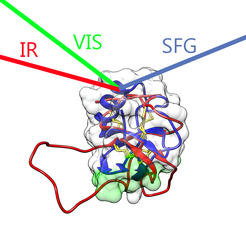DFG: "Shining Light on Nature’s Raincoat: Understanding the Unique Properties of Hydrophobin Films"

Hydrophobins are a group of highly surface active proteins that are produced by fungi and are known for their unique functions related to the interaction and control of interfaces. Hydrophobins largely reduce the surface tension of water, strongly adhere to surfaces and form protective surface coatings, all functions that play important roles in fungal physiology. Hydrophobins have also led to several industrial applications including foams, dispersions and functional coatings. Both biological and industrial applications rely on the unique surface properties of hydrophobin where the proteins self-assemble and form robust films. While much progress has been made in the characterization of the macroscopic structure of hydrophobin films, little is known about the initial stages of film formation and the microscopic structure of these extraordinary proteins at interfaces. Even less information is available on their dynamics, such as conformational fluctuations or intermolecular and solvent interactions. The reason for this lack in our knowledge is not the shortage of relevant questions but rather the lack of surface-sensitive techniques. Hence, definite molecular answers to even simple questions concerning the absolute orientation, dynamics and structure of hydrophobins are missing. Here I propose to study the molecular mechanism of hydrophobins using the advanced (nonlinear) technique of surface-specific sum-frequency generation (SFG) spectroscopy. This technique explores the properties of proteins and surrounding water through their intrinsic molecular vibrations. SFG experiments will be used to determine the structure and orientation of hydrophobins, adsorbed to relevant aqueous interfaces. Time-resolved SFG measurements will be used to determine vibrational lifetimes of particular vibrations of the proteins and to determine possible changes in conformations and solvent interactions. The improved understanding of the properties of these remarkable systems will surely accelerate the development of innovative materials and technologies and will allow deciphering their functional roles in nature.
